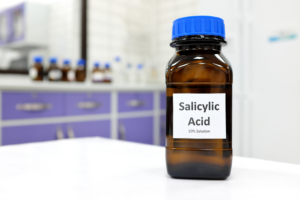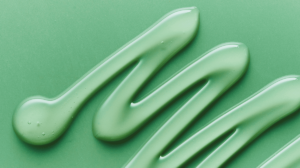
Salicylic acid is a popular skincare ingredient known for effectively tackling various skin issues. It is a type of beta hydroxy acid (BHA) derived from the bark of willow trees. The compound has been used for centuries in traditional medicine for its therapeutic properties. In modern times, it has gained immense popularity in the beauty and skincare industry due to its excellent exfoliating and anti-inflammatory properties.
Chemical Structure and Properties
Salicylic acid, also known as 2-hydroxybenzoic acid, has a simple chemical structure. The acid is colorless and crystalline, with a sweet yet bitter taste. It is used in various concentrations in skincare products, typically ranging from 0.5% to 2%.
Historical Uses
Salicylic acid dates back to ancient civilizations, where the bark of willow trees was used to treat pain and fever. In the 19th century, a synthetic form of salicylic acid called acetylsalicylic acid was created, now known as aspirin.
Today over the counter, salicylic acid is found as an active ingredient extensively used in skincare products, due to its remarkable benefits for the skin.
How Does Salicylic Acid Work?
Salicylic acid is a beta hydroxy acid (BHA) that is commonly used in various skincare products, especially for treating acne and other skin conditions. It works by exfoliating the skin and has several mechanisms of action:
- Unclogs Pores: One of the primary causes of acne is the clogging of pores with dead skin cells, sebum (oil), and bacteria. Salicylic acid is oil-soluble, which means it can penetrate the pores and help dissolve the excess oil and debris, unclogging the pores. “It is one of the most common ingredients Dermatologists will recommend to treat acne and address oily skin,” notes Dr. Lucy Chen.
- Exfoliation: Salicylic acid is a keratolytic agent that promotes the shedding of dead skin cells. It can break down the bonds between cells, removing the outermost layer of skin. By doing so, it helps to keep the pores clear and prevent new acne breakouts.
- Anti-inflammatory: Salicylic acid has mild anti-inflammatory properties that help reduce redness and swelling associated with acne and other skin irritations. It can calm the inflamed areas, making them look less irritated and promoting healing.
- Bacteria-fighting: Salicylic acid can also act against certain types of acne-causing bacteria. While it may not be as potent as other antibacterial agents, its ability to unclog pores and reduce inflammation indirectly helps control bacterial growth.
Salicylic acid is available in various forms, including gels, creams, cleansers, and spot treatments. It is essential to follow the instructions provided by the product and not overuse it, as excessive application can lead to dryness, irritation, and peeling of the skin. For individuals with specific skin conditions or concerns, it is always advisable to consult a dermatologist before using any new skincare product containing salicylic acid.
Benefits of Salicylic Acid for Skincare

1) Acne Treatment
Salicylic acid is highly effective in treating acne-prone skin. Its ability to exfoliate and unclog pores makes it an excellent choice for those struggling with acne breakouts.
2) Blackhead and Whitehead Removal
By dissolving the debris trapped within pores, salicylic acid aids in the removal of blackheads and whiteheads.
3) Improving Skin Texture
Regular use of salicylic acid can result in smoother and more even-textured skin, as it encourages the shedding of dead skin cells.
4) Reducing Inflammation and Redness:
Salicylic acid possesses anti-inflammatory properties, which help to soothe and calm irritated skin. This can be particularly beneficial for those with sensitive or acne-prone skin, as it can reduce redness and swelling associated with many patients with breakouts.
5) Exfoliation and Cell Renewal:
Salicylic acid is a beta-hydroxy acid (BHA) that gently exfoliates the skin’s surface. It penetrates deep into the pores and breaks down the bonds between the dead cells and skin cells, promoting cell turnover. Regular exfoliation with salicylic acid can result in a fresher, more radiant complexion.
6) Oil Control:
Salicylic acid is an excellent choice for acne treatments for individuals with oily skin as it helps regulate sebum production. Keeping excess oil in check can prevent clogged pores and reduce the likelihood of acne breakouts.
7) Hyperpigmentation Reduction:
Salicylic acid can assist in fading dark spots and post-inflammatory hyperpigmentation left behind by acne lesions. Its exfoliating action encourages the shedding of damaged skin cells, leading to a more even skin tone.
8) Pore Size Minimization:
Salicylic acid’s exfoliating and pore-cleansing properties can help minimize the appearance of enlarged pores. Keeping the pores clear of debris and excess oil can make them appear less noticeable.
Choosing the Right Salicylic Acid Product
Different Concentrations
When selecting a salicylic acid product, consider your skin type and the severity of your skin issues. Products with lower concentrations are ideal for beginners, while higher concentrations are better suited for those with more persistent skin concerns.
Formulations (Gels, Cleansers, Pads, etc.)
Salicylic acid is available in various formulations, including gels, cleansers, toners, and pads. Choose a product that fits seamlessly into your skincare routine.
How to Use Salicylic Acid Safely
Using salicylic acid safely involves following some important guidelines to minimize the risk of irritation and other potential side effects. Salicylic acid is commonly used in various skincare products for its exfoliating properties and is effective in treating acne, blemishes, and certain skin conditions.
“The key is to not use too many products containing salicylic acid, otherwise you run the risk of drying out the skin,” explains Dr. Chen.
Here are some tips for using it safely:
- Start with a low concentration: If you’re new to salicylic acid, begin with a product with a lower concentration (usually around 0.5% to 2%). This allows your skin to acclimate to the acid and reduces the likelihood of irritation.
- Patch test first: Before applying salicylic acid to a larger skin area, perform a patch test on a small, inconspicuous area. Apply a small amount of the product and wait 24 hours to check for any adverse reactions like redness, itching, or burning.
- Follow product instructions: Always read and follow the instructions provided by the manufacturer. Pay attention to the recommended usage frequency and duration.
- Use it sparingly: More does not necessarily mean better. Use only a pea-sized amount for the targeted area to avoid over-exfoliation and irritation.
- Avoid sensitive areas: Avoid salicylic acid from the delicate skin around the eyes, nostrils, and mouth. It’s best to apply it to areas with specific concerns, such as acne-prone areas.
- Use sunscreen: Salicylic acid can make your skin more sensitive to the sun, so it’s crucial to wear sunscreen with a high SPF during the day. This protects your skin from harmful UV rays and reduces the risk of sunburn.
- Don’t use it with other exfoliants: Avoid using salicylic acid and other chemical exfoliants, such as glycolic acid or retinoids, unless directed by a healthcare professional or dermatologist. Combining multiple exfoliants can increase the risk of irritation.
Precautions and Side Effects
Allergic Reactions
If you experience any allergic reactions, such as itching, redness, or swelling, discontinue use immediately and consult a dermatologist.
Irritation and Dryness
Excessive use of topical salicylic acid can lead to allergic reactions and skin dryness and irritation. Follow the recommended guidelines to prevent these side effects.
Pregnancy and Breastfeeding
Consult your healthcare professional before using salicylic acid products if pregnant or breastfeeding.
Salicylic Acid for Various Skin Types
Oily Skin
Salicylic acid is particularly beneficial for individuals with oily skin, as it helps regulate sebum production and prevent clogged pores.
Dry Skin
Those with dry skin should use salicylic acid cautiously and follow up with a nourishing moisturizer to minimize dryness.
Sensitive Skin
For individuals with sensitive skin, it is essential to start with a low concentration of salicylic acid and use high concentrations of it sparingly to avoid skin irritation..
Addressing Common Myths about Salicylic Acid
Chemical Peeling Misconceptions
Salicylic acid is often used in chemical peels and other medications, but it is essential to understand the process and potential risks before trying this treatment.
Discoloration and Skin Damage
Contrary to some misconceptions, salicylic acid does not cause skin discoloration or permanent damage when used correctly.
Fast Facts
| Definition | Salicylic acid is a beta hydroxy acid (BHA) derived from willow bark or synthesized from phenol. |
| Cosmetic Use | Commonly used in skincare products to treat acne, exfoliate dead skin cells, and improve texture. |
| Impact on Skin Types | Suitable for oily and acne-prone skin. It may be too harsh for dry or sensitive skin. |
| Potential Benefits | Helps unclog pores, reduces acne, fades hyperpigmentation, and promotes skin cell turnover. |
| Drawbacks | Overuse can cause dryness, redness, and irritation. Not recommended during pregnancy. |
| Recommended Usage | 2-3 times per week for most skin types. Adjust based on individual tolerance and skin response. |
| Compatibility with Other Ingredients | Combines well with other exfoliating agents like glycolic acid and non-irritating hydrating agents. |
| Precautions/Recommend | Patch test before use. Avoid contact with eyes and mucous membranes. |
| Who Should Use | Those with acne-prone or congested skin seeking exfoliation and acne treatment. |
| How Often to Use | Start with once a week and gradually increase. Avoid daily use, especially for sensitive skin. |
| Works Well With | Hyaluronic acid, niacinamide, aloe vera, and lightweight, non-comedogenic moisturizers. |
| Don’t Use With | Avoid using with other strong exfoliants, retinoids, or products containing benzoyl peroxide. |
Conclusion
Salicylic acid is a powerful and versatile skincare ingredient that offers numerous benefits for acne and other skin concerns. When used correctly and safely, it can significantly improve the texture and appearance of the skin. However, it is essential to understand your skin type, follow the usage guidelines, and consult a dermatologist doctor if you have any specific concerns.


